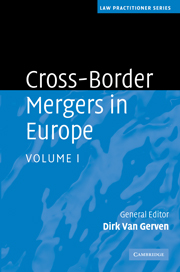Book contents
- Frontmatter
- Contents
- Contributors
- Preface
- Part I EC rules on cross-border mergers
- Part II Application in each Member State National reports for the EU Member States
- 5 Austria
- 6 Belgium
- 7 Bulgaria
- 8 Cyprus
- 9 Czech Republic
- 10 Denmark
- 11 Estonia
- 12 Germany
- 13 Hungary
- 14 The Netherlands
- 15 Poland
- 16 Slovak Republic
- 17 United Kingdom
- Part III Application in the EEA Member States
- Part IV Annexes
- Index
11 - Estonia
from Part II - Application in each Member State National reports for the EU Member States
Published online by Cambridge University Press: 03 May 2010
- Frontmatter
- Contents
- Contributors
- Preface
- Part I EC rules on cross-border mergers
- Part II Application in each Member State National reports for the EU Member States
- 5 Austria
- 6 Belgium
- 7 Bulgaria
- 8 Cyprus
- 9 Czech Republic
- 10 Denmark
- 11 Estonia
- 12 Germany
- 13 Hungary
- 14 The Netherlands
- 15 Poland
- 16 Slovak Republic
- 17 United Kingdom
- Part III Application in the EEA Member States
- Part IV Annexes
- Index
Summary
Introduction
1. In Estonia, cross-border mergers are regulated mainly by Part IX, Chapter 6 of the Commercial Code (Äriseadustik). The Act on Amendment of the Commercial Code and Related Acts (Äriseadustiku ja sellega seonduvate seaduste muutmise seadus), implementing the provisions of the Cross-border Merger Directive, was passed by the Estonian parliament on 21 November 2007 and came into force on 15 December 2007, i.e. by the deadline prescribed by the Directive. In addition to the Commercial Code, the act introduced amendments to the Community-scale Involvement of Employees Act (Töötajate üleühenduselise kaasamise seadus) and legislation regulating mergers of financial institutions.
Scope of the new rules
2. The rules on cross-border mergers apply to public limited companies (aktsiaselts or AS) and private limited companies (osaühing or Oü) registered with the Estonian Commercial Register (Art. 433(1) Commercial Code). As such, the relevant provisions potentially also apply to European Companies (SEs) registered in Estonia since SEs are, to the extent not regulated by rules specifically applicable to SEs, governed by rules applicable to public limited companies.
3. In addition to limiting the scope to these two types of companies, the Commercial Code explicitly excludes applicability of the relevant section of the Commercial Code to commercial cooperative societies (tulundusühistu) as permitted under Article 3(2) of the Cross-border Merger Directive (Art. 433(3) Commercial Code).
- Type
- Chapter
- Information
- Cross-Border Mergers in Europe , pp. 184 - 196Publisher: Cambridge University PressPrint publication year: 2010



